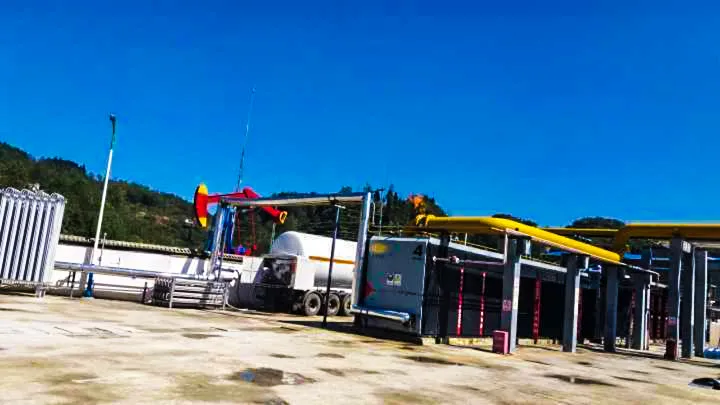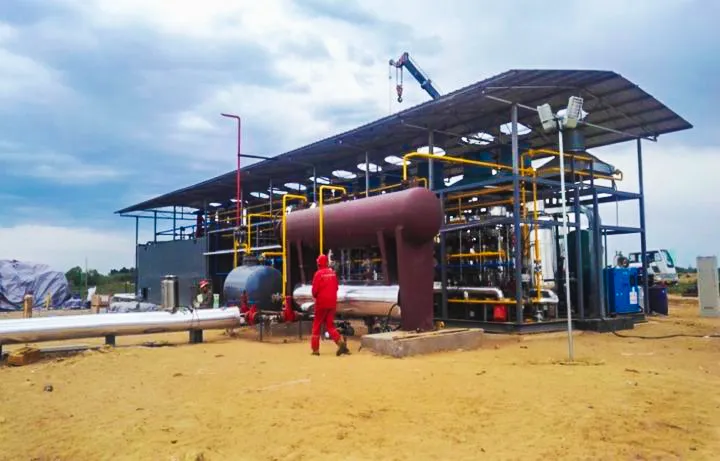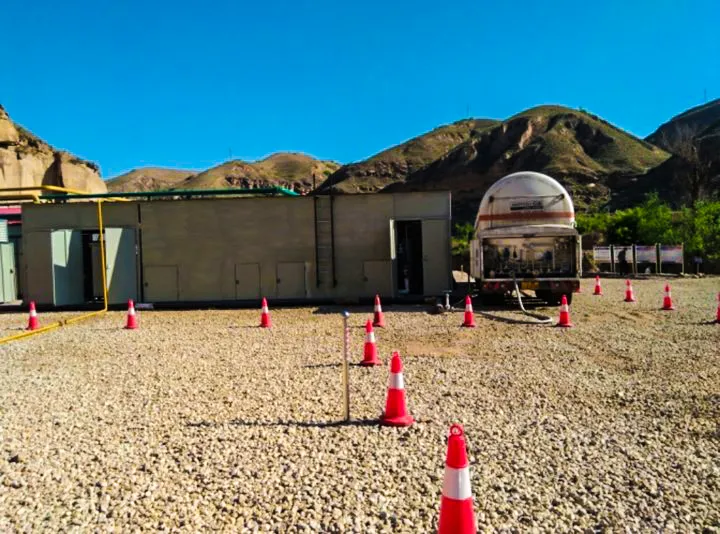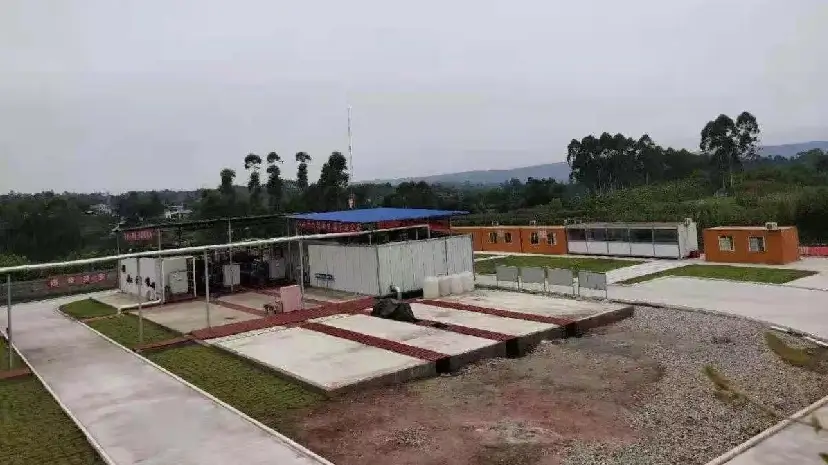What Is the Marcellus Shale?-North America’s Richest Natural Gas Resource Formation
The Marcellus Shale is more than just a layer of rock beneath the surface — it is one of the largest and most productive natural gas sources in North America. Spanning multiple U.S. states, it supplies nearly one-third of the country’s natural gas, revolutionizing the energy market, influencing global geopolitics, and creating new opportunities for advanced resource recovery companies such as KAITIANGAS.
What Is the Marcellus Shale?
The Marcellus Shale is a natural gas-rich black shale formation primarily located in the Appalachian Basin of the northeastern United States. It formed during the Early Devonian Period (approximately 390 million years ago) through the accumulation and burial of organic-rich sediments in a shallow marine environment.
- Origin of Name: Named after the town of Marcellus, New York, first designated by geologist J. Hall in 1839.
- Rock Characteristics: A black, organic-rich, fine-grained shale with variable thickness. It is a major source rock for shale gas.
- Commercial Discovery: From 2004 to 2007, advances in horizontal drilling and hydraulic fracturing enabled widespread commercial development.
- Mineral Rights Ownership: Mostly held by private landowners or leasing companies. Oil and gas firms typically operate under a lease + royalty structure.
| Geological Parameter | Value / Description |
| Geologic Age | Middle Devonian (approx. 390–360 million years ago) |
| Thickness | 15–90 meters (locally exceeds 150 meters) |
| Depth | 1,200–2,400 meters (moderate depth) |
| TOC (Organic Carbon) | 8–15% (excellent hydrocarbon potential) |
| Thermal Maturity (Ro%) | 1.1–3.0% (within dry gas window) |
| Lithology | Mainly shale, with interbedded limestone and siltstone; dense and requires hydraulic fracturing |
How Did the Marcellus Shale Form?
The formation of the Marcellus Shale involved a multi-stage geologic process:
Formation Process = Devonian Shallow Sea → Organic Deposition → Burial & Thermal Cracking → Diagenesis → Gas Sealing in Shale
| Stage | Time | Key Process | Environment | Result |
| 1. Deposition | ~390 million years ago | Sediments are buried and compressed | – Low-oxygen waters – High microbial die-off | Black, organic-rich sediments formed |
| 2. Burial & Compaction | Over millions of years | Methane, ethane, and other hydrocarbons are generated | – Rising pressure – Water expelled | Porosity reduced, shale structure formed |
| 3. Thermal Maturation | Temperature reached 60–150°C | Organic matter “cooked” into hydrocarbons | – Deep burial – High geothermal gradient | Methane, ethane, and other hydrocarbons generated |
| 4. Diagenesis & Fracturing | Long-term tectonic evolution | Mineral cementation, fracture development | – Quartz and calcite precipitated – Brittle zones developed | Formed ideal conditions for hydraulic fracturing |
| 5. Preservation | Present day | Gas sealed in rock | – Low permeability – Natural fractures present | Gas trapped in pore spaces and microfractures |
- Northern areas (e.g., NE Pennsylvania): Dominated by dry gas
- Southwestern areas (e.g., West Virginia): Rich in wet gas/NGLs
- High quartz content (>40%) enhances brittleness, ideal for fracking
- Depositional environment similar to modern Black Sea (deep, anoxic)
Where Is the Marcellus Shale Located?
The Marcellus Shale spans six U.S. states and is the core region for shale gas development in North America.
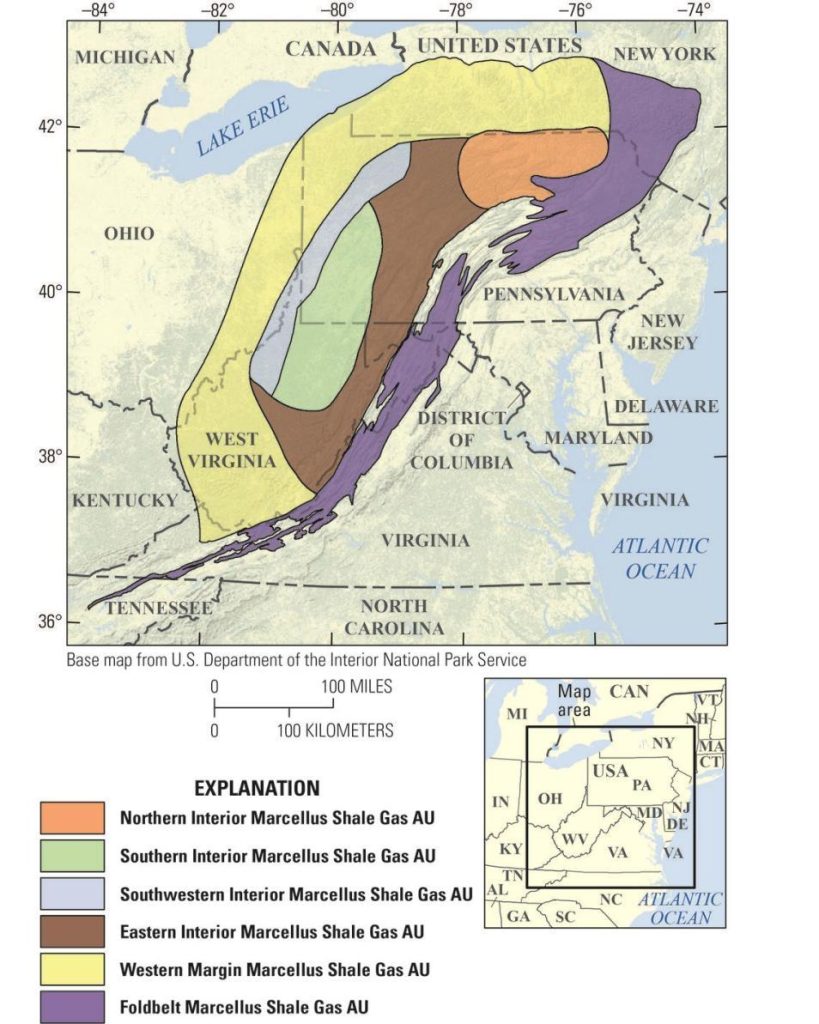
| State | Development Status | Remarks |
| Pennsylvania | Actively developed | Rich dry gas resources and robust infrastructure |
| West Virginia | Actively developed | Wet gas and NGL-rich zones, especially near Ohio |
| New York | Banned | Has reserves, but fracking is prohibited |
| Ohio | Secondary area | Borders Utica Shale, strong potential |
| Maryland | Limited development | Heavily regulated |
| Virginia | Minimal development | Only touches shale in the northwest |
- Depth: 1,500–2,700 meters
- Thickness: 15–90 meters (up to 300 meters locally)
How Much Gas Does the Marcellus Shale Contain?
According to the U.S. Energy Information Administration (EIA):
- Technically recoverable gas: Over 1,400 trillion cubic feet (Tcf)
- Current daily production (2024): ~27 billion cubic feet/day (Bcf/d)
- EUR per well: 0.8–2.0 Bcf, depending on location and completion design
- Accounts for 25%+ of U.S. natural gas supply
Strategic Significance of the Marcellus Shale for North America
Largest Shale Gas Resource in North America
- EIA (2023): 410+ Tcf of recoverable shale gas
- Over 30% of all U.S. shale gas reserves
Reduces Dependence on Imports
| Year | U.S. Net Natural Gas Imports (Tcf) | Notes |
| 2007 | +4.6 (net importer) | LNG import peak |
| 2017 | -0.3 (net exporter) | Became net exporter |
| 2023 | -4.7 | World’s largest LNG exporter |
Marcellus accounts for 35–40% of U.S. gas production.
Significantly Lowers U.S. Gas Prices
| Year | Henry Hub Spot Price ($/MMBtu) | Notes |
| 2005 | $13.42 | Post-Hurricane Katrina shock |
| 2012 | $2.75 | Shale boom drove prices down |
| 2023 | $2.60–$3.50 | Long-term low, stable pricing |
Result: Lower energy costs for power, industry, and heating.
Revitalizes Manufacturing & Export Economy
- Major chemical investments: Dow, Shell, ExxonMobil have built multi-billion-dollar ethane crackers near Marcellus
- NGL products: Rich in ethane and propane — key feedstock for U.S. chemical exports
- Natural gas replaces coal: Cleaner, more flexible electricity generation
Reduces Carbon Emissions
| Metric | 2005 | 2022 | Change |
| Nat. gas share of power | 19% | 41% | ×2 increase |
| Coal share of power | 50% | 19% | ↓ 60% |
| Energy CO₂ emissions | ~6 GT | ~5 GT | ↓ ~17% |
Natural gas emits 50% less CO₂ than coal, making it a core transition fuel.
Increases Geopolitical Autonomy
- U.S. LNG exports to Europe replace Russian supply (especially post-2022 conflict)
- Pricing shift: Global LNG increasingly tied to Henry Hub rather than Brent crude
- U.S. regains global energy leadership
How Is Marcellus Gas Extracted?
Two key technologies:
- Horizontal Drilling: Begins vertically, then turns horizontally through the shale layer
- Hydraulic Fracturing (Fracking): Injects high-pressure fluid to crack rock and release gas
KAITIANGAS: A Professional Shale Gas Recovery Solution
As a specialized shale gas technology provider, Kaitiangas offers end-to-end lifecycle solutions: From consulting to construction, equipment integration, and intelligent operations, we help clients achieve higher efficiency and faster ROI. Our Core Services Include:
- Feasibility consulting
- Engineering design & system integration
- EPC general contracting + specialized equipment
- Automated commissioning & smart O&M systems

